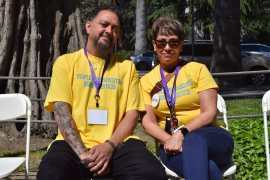Low-income Californians who are elderly and disabled were less likely to go to the emergency room or be hospitalized after their in-home caregivers participated in an intensive training program, according to a report.
Under a pilot program, nearly 6,000 aides in Los Angeles, San Bernardino and Contra Costa counties were trained in CPR and first aid, as well infection control, medications, chronic diseases and other areas. All were workers of the In-Home Supportive Services program, who are paid by the state to care for low-income seniors and people with disabilities, many of them relatives.
Researchers at the University of California, San Francisco based their analysis on the results in Contra Costa County, which they said produced the most complete and reliable data.
UCSF professor emeritus Bob Newcomer said they compared insurance claims on 136 at-risk elderly and disabled residents whose caregivers were trained with the claims from more than 2,000 similar residents whose caregivers did not receive the training. Though the sample was small, Newcomer said he was encouraged by the findings.
“Training shows a lot of promise,” he said.
The rate of repeated emergency room visits declined by 24 percent, on average, in the first year after caregivers were trained and 41 percent in the second year, according to the UCSF analysis.
The demand for in-home caregivers is rising nationwide as the population ages and people develop dementia or live longer with chronic diseases. Caregivers typically help elderly and disabled people with bathing, dressing, eating and getting to medical appointments. The work is largely unpaid and done by family members, but some states pay caregivers for eligible low-income residents through their Medicaid programs.
There are currently no federal training requirements for in-home caregivers, even if they are paid with taxpayer dollars. Around the country, however, training programs have been developed and tested, according to the Paraprofessional Healthcare Institute, an advocacy group that also provides training. Among the states that have tried different types of instruction are Massachusetts, North Carolina and Michigan.
California’s In-Home Supportive Services program pays caregivers to help about half a million elderly and disabled people stay in their homes rather than be placed in institutions. To qualify for the care, seniors must be eligible for Medi-Cal, be 65 or older, and be blind or disabled.
The goal of the pilot program was to determine whether educating IHSS caregivers and integrating them into the medical team would improve the health of their patients. The training was conducted by the California Long-Term Care Education Center under a three-year, $11.8 million grant from the federal Centers for Medicare & Medicaid Services. The center, which released the report on the results of the pilot program, worked in conjunction with UCSF.
The caregivers in all three counties, 44 percent of whom did not have a high school education, voluntarily attended about 60 hours of classes and completed 13 hours of related work at home. The people they cared for also took part in some of the classes, which were conducted in several languages.
Caregivers who were trained told researchers they felt better equipped to do their jobs and communicate with clients and their doctors, according to the report.
One of the caregivers, Andrew O’Bryan, said he was especially happy to learn CPR in case his mother has an emergency. For more than eight years, he has been paid by IHSS to care for his 67-year-old mom, Anabelle O’Bryan, who he said has diabetes, congestive heart failure, arthritis and high blood pressure.
O’Bryan, who lives in Oakley, a city in Contra Costa County, said he also learned what to ask when he accompanies her to the doctor and how to decide if she needs to go to the hospital.
“Now I am more equipped to spot things” before they get worse, he said.
For example, O’Bryan said he knows to elevate her feet when they get swollen rather than immediately take her to the ER.
Annabelle O’Bryan said she is more confident in her son’s abilities after he took the class, and she knows that he is helping her stay healthier.
“He is really on top of me not eating the sugar,” she said. “He is really careful about that.”
Newcomer of UCSF said that because the caregivers are in the patients’ homes for hours, they can be the “eyes and the ears” for physicians and other medical providers. They can tell the doctors “if the person is more confused, or is refusing to eat, or that the status is changing,” he said.
The results of the study show that caregivers play a pivotal role in helping keep people out of the hospital, said Corinne Eldridge, executive director of the California Long-Term Care Education Center. The nonprofit center was founded in 2000 by members of the Service Employees International Union, which represents many IHSS workers.
During the training sessions, Eldridge said, the caregivers learned skills such as how to read medication labels or provide the best diet for a diabetic patient. Like Andrew O’Bryan, they also became more confident about handling worrisome situations, such as deciding when to call a doctor or dial 911.
Eldridge said the center is now hoping to gain support from Medi-Cal health plans to help pay for the training as a way to reduce health care costs.
“We really see training as part of the solution in order to provide better care … and frankly as a way to invest in the workforce,” she said.
Blue Shield of California Foundation helps fund KHN coverage in California.






